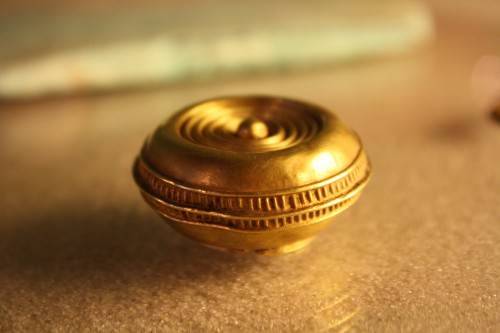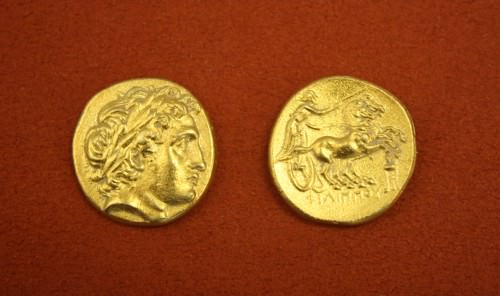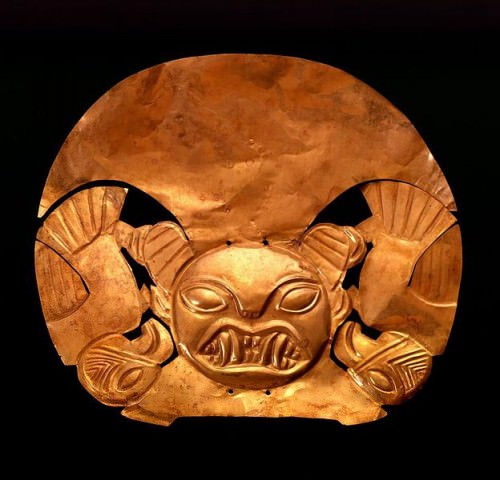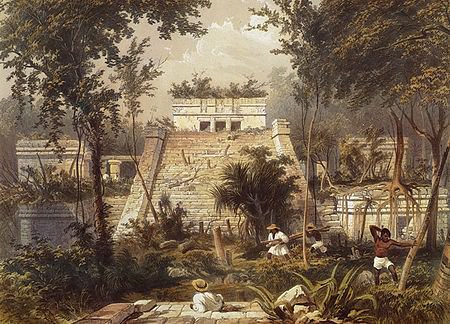Gold in Antiquity › The Classic Maya Collapse » Origins and History
Articles and Definitions › Contents
- Gold in Antiquity › Ancient History
- The Classic Maya Collapse › Antique Origins
Ancient civilizations › Historical places, and their characters
Gold in Antiquity › Ancient History
Definition and Origins

Gold, chemical symbol Au (from the Latin aurum meaning 'shining dawn'), is a precious metal which has been used since antiquity in the production of jewellery, coinage, sculpture, vessels and as a decoration for buildings, monuments and statues.
Gold does not corrode and so it became a symbol of immortality and power in many ancient cultures. Its rarity and aesthetic qualities made it an ideal material for ruling classes to demonstrate their power and position. First found at surface level near rivers in Asia Minor such as the Pactolus in Lydia, gold was also mined underground from 2000 BCE by the Egyptians and later by the Romans in Africa, Portugal and Spain. There is also evidence that the Romans smelted gold particles from ores such as iron pyrites. Easily worked and mixed with other metals such as silver and copper to increase its strength and change its colour, gold was used for a wide range of purposes.
JEWELLERY
In most ancient cultures gold was popular in jewellery and art because of its value, aesthetic qualities, ductility and malleability.Electrum (the natural alloy of gold and silver) was used in jewellery by the Egyptians from 5000 BCE. Gold jewellery was worn by both men and women in the Sumer civilization around 3000 BCE and gold chains were first produced in the city of Ur in 2500 BCE. The Minoan civilization on Crete in the early 2nd millennium BCE is credited with producing the first cable chain jewellery and the Minoans made a vast array of jewellery items using an extensive range of techniques. Gold jewellery took the form of necklaces, bracelets, earrings, rings, diadems, pendants, pins and brooches. Techniques and shapes included filigree (a technique known to the Egyptians from 2500 BCE) where the gold is pulled into wire and twisted into different designs), beaten thin shapes, granulation (surface decoration with small, soldered granules of gold), embossing, chasing, inlaying, moulding and engraving. In South America, gold was similarly worked by the Chavin civilization of Peru around 1200 BCE and gold casting was perfected by the Nazca society from 500 BCE. The Romans used gold as a setting for precious and semi-precious gemstones, a fashion continued into the Byzantine era with the use of pearls, gems and enamels.

Neolithic Gold Bead
THE VALUE AND BEAUTY OF GOLD MADE IT AN IDEAL MATERIAL FOR PARTICULARLY IMPORTANT POLITICAL AND RELIGIOUS OBJECTS.
CURRENCY
Gold was first used as coinage in the late 8th century BCE in Asia Minor. Irregular in shape and often with only one side stamped, the coins were usually made of electrum. The first pure gold coins with stamped images are credited to king Croesus of Lydia, 561-546 BCE and a contemporary gold refinery has been excavated at the capital, Sardis. Even the purest naturally occurring gold can contain 5% silver but the Lydians were able to refine their gold using salt and furnace temperatures of between 600 and 800°C. The salt mixed with the silver and formed a vapour of silver chloride leaving behind pure gold which could be used to create a standardised coinage of guaranteed gold content. The Mycenaean civilization also widely used gold coins, as did the later Greek and Roman Empires, although silver was the more usual material used. One of the most famous gold coins in antiquity was the Roman bezant. First introduced in the reign of Emperor Constantine it weighed up to 70 Troy grains and was in currency from the 4th to the 12th centuries CE.

Macedonian Gold Stater
RELIGIOUS ARTEFACTS & OTHER USES
The value and beauty of solid gold made it an ideal material for particularly important political and religious objects such as crowns, sceptres, symbolic statues, libation vessels and votive offerings. Gold items were sometimes buried with the dead as a symbol of the deceased's status and the conspicuous (and non-profitable) consumption of such a rare and valuable material must surely have been designed to impress. Perhaps the most famous example is the so-called mask of Agamemnon found at Mycenae. In the Inca civilization of Peru gold was considered the sweat of the sun god Inti and so was used to manufacture all manner of objects of religious significance, especially masks and sun disks. In ancient Colombia gold was similarly revered for its lustre and association with the sun and in powdered form was used to cover the body of the future king in a lavish coronation ceremony which gave rise to the legend of El Dorado.
As a decorative covering, gold plate and gold leaf (gold beaten into extremely thin sheets) have been used to decorate shrines, temples, tombs, sarcophagi, statues, ornamental weapons and armour, ceramics, glassware and jewellery since Egyptian times. Perhaps the most famous example of gold leaf from antiquity is the death mask of King Tutankhamun.
Gold, with its malleability and incorruptibility, has also been used in dental work for over 3000 years. The Etruscans in the 7th century BCE used gold wire to fix in place substitute animal teeth. As thread, gold was also woven into fabrics. Gold has also been used in medicine, for example, Pliny in the 1st century BCE suggests gold should be applied to wounds as a defence to 'magic potions'.

Moche Gold Headdress
GRADING GOLD
Concerns over the authenticity of gold led the Egyptians to devise a method to determine the purity of gold around 1500 BCE (or earlier). This method is called fire assaying and involves taking a small sample of the material under test and firing it in a small crucible with a quantity of lead. The crucible was made of bone ash and absorbed the lead and any other base metals during the firing process leaving only gold and silver. The silver was removed using nitric acid and the remaining pure gold was weighed and compared to the weight before firing. Archimedes was also aware that the specific gravity of gold is altered depending on the percentage content of base metals, pure gold having twice the gravity of silver for example.
Gold is such a precious material that for centuries various attempts were made to produce it through alchemy - that is the chemical transformation of base metals into gold using the philosopher's stone ( lapis philosophorum ). First attempts were made in China in the 4th century BCE and also in ancient Greece and although unsuccessful, nevertheless, the activity laid the foundations of modern chemistry.
The Classic Maya Collapse › Antique Origins
Ancient Civilizations
The Terminal Classic period in Mesoamerica between c. 800 and 925 CE saw one of the most dramatic civilization collapses in history. Within a century or so the flourishing Classic Maya civilization fell into a permanent decline, so that once great cities were abandoned and left to ruin, in many cases, to be reclaimed by the jungle and so disappear from human memory for centuries. Some northern Maya cities, conversely, prospered like never before in this period, as did the Maya along the Gulf Coast and central highlands of Mexico; however, for the majority of the Maya in the southern lowlands, the period was nothing short of disaster and, as the historian ME Coe describes, 'This was surely one of the most profound social and demographic catastrophes of all human history'. The question, then, which has preoccupied scholars ever since the re-discovery in the 19th century CE of mysterious ruins built by, at the time, an equally mysterious civilization, is why did this happen? Below are some of the reasons presented by historians today as to just what caused such a dramatic reversal in fortunes.

Temple at Tulum by Catherwood
THEORY & FACTS
Early in the study of the Maya collapse all manner of theories were presented as to what exactly had happened, some more plausible than others. Disease, a social revolution, drought, famine, foreign invasion, over-population, disruption in trade routes, earthquakes, and even hurricanes were held responsible. Unfortunately, the inscriptions left by the Maya themselves are strangely silent on the topic. To find the answer, then, we must reconstruct the past starting with what we do know. From the mid to late 8th century CE, relations between city -states deteriorated. There was a decline in trade and an increase in armed conflicts. We know that the death-rate increased in this period, and from 830 CE no new buildings were constructed in the central Maya area. As the Maya were fond of writing dates on their monuments and stelae, it is interesting to note that no dates after c. 910 CE are seen in the lowlands sites.
FROM THE MID TO LATE 8TH CENTURY CE RELATIONS BETWEEN CITY-STATES DETERIORATED. THERE WAS A DECLINE IN TRADE AND AN INCREASE IN ARMED CONFLICTS.
We also have evidence of large areas becoming completely depopulated and royal dynasties and elites disappearing without trace. Finally, we can say that the collapse was neither unique - smaller scale abandonment of Maya cities had occurred several times before over the centuries - nor was it a sudden one but rather a process of decline which occurred over a period of 150 years between c. 760 and c. 910 CE. Such a slow decline would seem to cross off the list disease pandemics and natural disasters, like earthquakes, as factors in the collapse. Further, in both these cases populations tend to recover relatively quickly, whereas the Maya lowlands were never significantly re-populated.
Then we must also consider what we do not know about the Maya civilization, as different guesses and interpretations of these points can colour the reasons proposed for the collapse. We do not know with any great accuracy the population figures in the Late Classic period. Nor do we know exactly how the Maya farmed, how agricultural production was managed and controlled, or whether trade of this produce was local, regional, or even cross-cultural. These are the facts of the matter and the latest state of knowledge on the subject; now let us examine the various theories of how the Maya arrived at this situation.

Mayan Glyphs
WHAT CAUSES CIVILIZATIONS TO COLLAPSE?
Firstly, it has been fruitful to note the process of collapse in other civilizations, such as the Roman Empire. Differences in time, geography, and circumstances mean no direct correlations are possible, but the outstanding point of similarity is that no single factor accounts for a large civilization's collapse. Perhaps another similarity in the complex process which brought the downfall of other empires is the general disregard of rulers for the resources at their disposal and the long-term welfare of the people they ruled. Was this also the case with the Maya? The period prior to the Maya collapse is certainly characterised by extravagant building projects, unproductive wars, and over-exploitation of natural resources, especially land, forests, and water. An ever increasing population may well have driven the Maya to deforest areas which were subsequently eroded. One case which points to the running out of resources is the curious change in wood used in Maya buildings. Sapodilla was the architect's choice prior to the 740s CE for such details as lintels but was then replaced by the inferior wood of the smaller logwood tree. Sapodilla did make something of a comeback, but beams were never the thickness as previously. Had the Maya exhausted their supply of Sapodilla? Had the tree recovered over time or did the Maya even establish protected areas to specifically cultivate the tree?
THREE MAIN FACTORS
Maya historians have generally settled on a combination of three main factors which could have caused the Maya collapse: warfare between city-states, overpopulation, and drought. The factors were not always contemporary or found all together in a single city.
Warfare had been a part of Maya culture for centuries, but its intensification and scale increased prior to the collapse so that cities began to build fortifications. Previously, warfare had often been token, in that defeat might result in only a small number of important figures being taken as captives. By the Late Classic period, war seems to have been much more damaging to all involved. The conquest of territory and the capturing of a large number of sacrificial victims now became a priority - the former perhaps to increase agricultural production and acquire resources and the latter to appease the gods and return to the more stable times of earlier centuries. The presence of large numbers of arrow heads at certain sites is further evidence that life in the cities was becoming more precarious.

Presentation of Captives to a Maya Ruler
There may also have been a military threat from foreign states. Supporting the invasion theory are several archaeological finds, notably at Ceibal where a figure known as 'Wat'ul' is depicted who has a distinctly non-Maya moustache and hairstyle but who is wearing Maya costume; stelae with glyphs which are not Mayan; a figure in a mask of Ehecatl ; the wind god of central Mexico; and the presence of Fine Orange pottery from the Gulf coast. However, such evidence seems sparse to what one would expect to find if the collapse were down to foreign invasion and, significantly, few cities display evidence of deliberate destruction.
Over-population may well have put an unbearable strain on the agricultural production the Maya were capable of managing.Ever more archaeological evidence shows that Maya cities and peripheral settlements were much more heavily populated than previously imagined. Even worse, scientific evidence clearly indicates that the Maya lowlands suffered a sustained series of droughts between c. 800 and c. 1050 CE. However, it should be noted that not all cities suffered from droughts, as some lakes and rivers never dried up completely. For those regions which did suffer a water shortage, the lack of rain and repeated crop failures make it entirely conceivable that either the lower levels of society - 90% of the population were farmers - or perhaps more likely, non-ruling elites, rebelled against the ruling class, who could no longer justify their role as protectors of society and intermediaries with the gods such as Chahk the rain god. With the consequent collapse of the social structure and city infrastructure, those who could may well have migrated to the north and south and the early Colonial chronicles written in Yucatan Mayan do indeed describe a 'Great Descent' and a 'Lesser Descent'. There is no archaeological record of such a large population movement, only that after the collapse, the 60,000 square miles of the Maya lowlands was deserted.
CONCLUSION
The most reasonable explanation, then, for the Classic Maya collapse is a combination of inter-connected factors. Warfare, social disorder, over-population, and unfavourable climatic conditions combined, perhaps not all together and in varying degrees and with different timing and sequence depending on location, to bring an end to the established order of the southern Maya lowlands.
As already stated, the Classic Maya collapse was not the end of the Maya culture. Northern cities and those in the highlands of Mexico and Guatemala survived up to the Spanish Conquest, and even today seven million people speak Mayan in Mesoamerica. The Maya culture suffered a terrible blow, but it did not disappear completely. In the power vacuum and general social upheaval left by the collapse, one group seized the opportunity to achieve regional dominance: this was the Toltec civilization, and it was they who would pass on the baton of Mesoamerican culture which had begun with the Olmec, been perfected by the Maya, and would end with the Aztecs.
LICENSE:
Article based on information obtained from these sources:with permission from the Website Ancient History Encyclopedia
Content is available under License Creative Commons: Attribution-NonCommercial-ShareAlike 3.0 Unported. CC-BY-NC-SA License